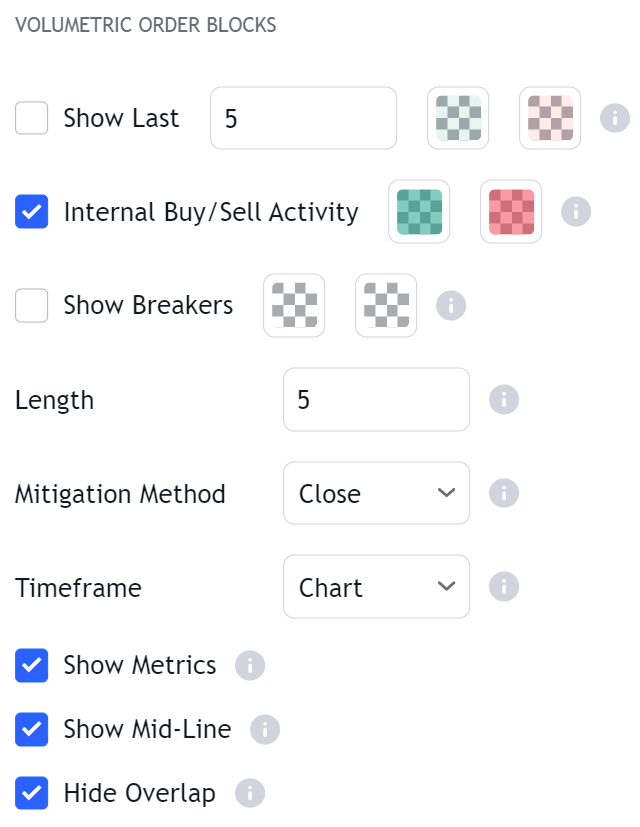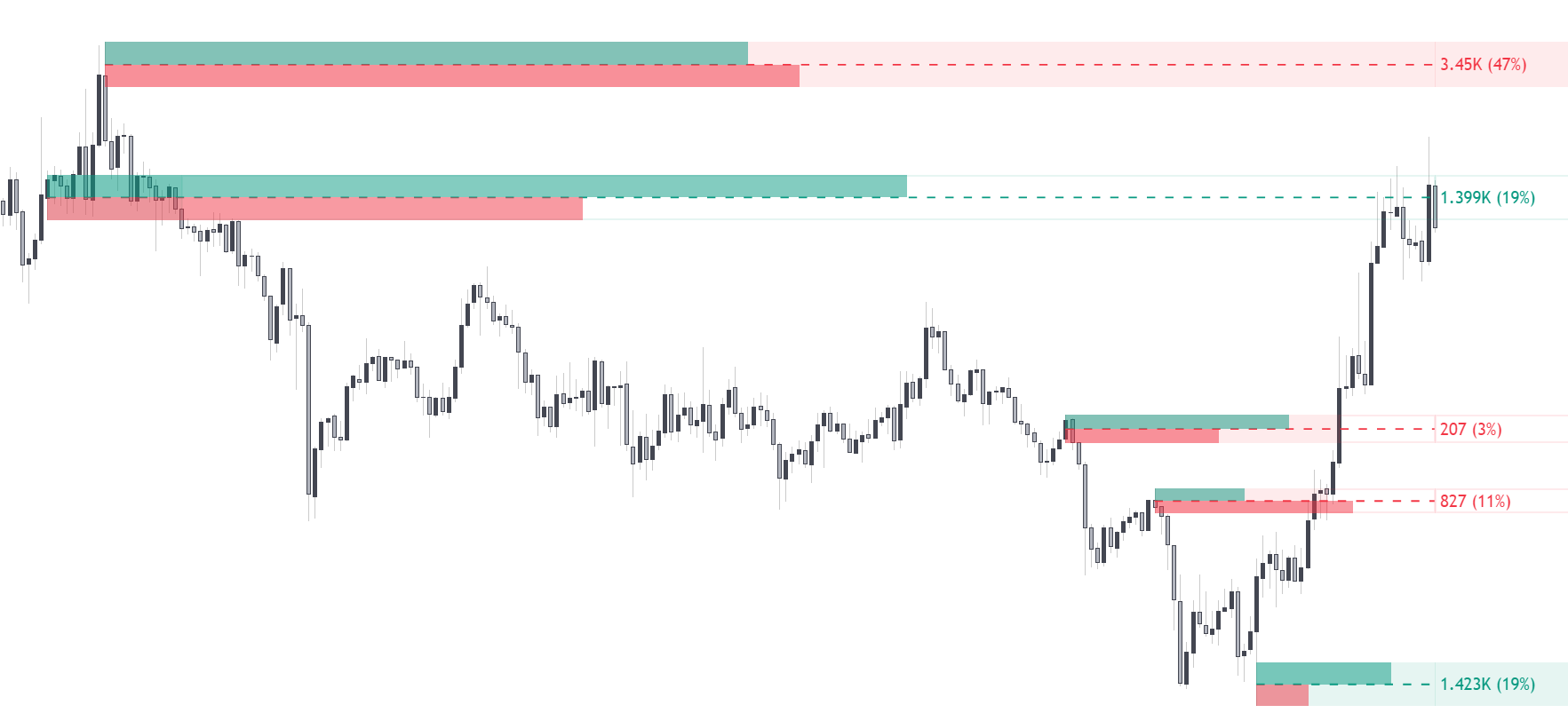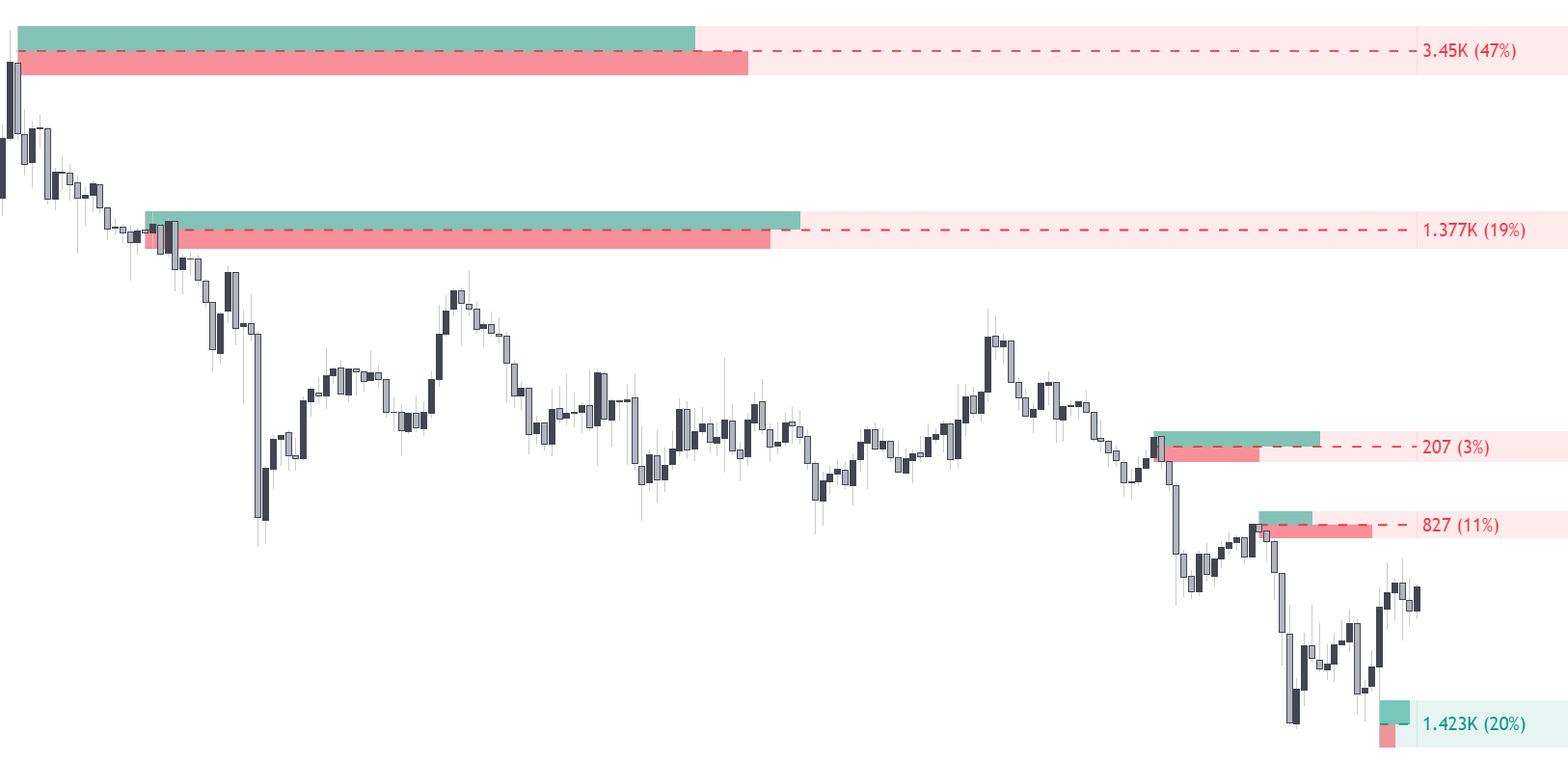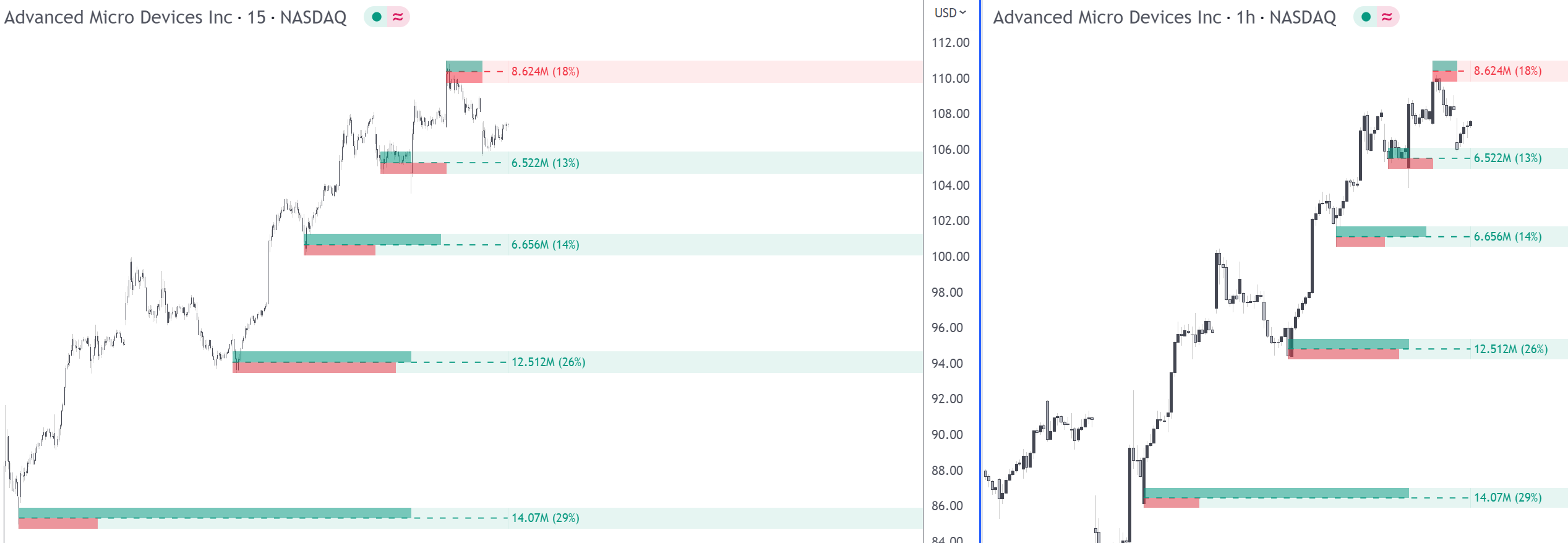Volumetric Order Blocks highlight price areas where more informed market participants accumulate orders and can be used as potential areas of support or resistance. These are automatically highlighted by the toolkit and will disappear once mitigated.
 These order Blocks are separated into two types, bullish Volumetric Order Blocks and bearish Volumetric Order Blocks. Bullish Volumetric Order Blocks initial locations are near swing low’s and are used as a potential support. On the other hand Bearish Volumetric Order Blocks initial locations are near swing high’s and are used as a potential resistance.
Users can show longer term Volumetric Order Blocks by increasing the Length setting in the Order Blocks section. This setting control the swing point detection lookback used to construct Volumetric Order Blocks.
These order Blocks are separated into two types, bullish Volumetric Order Blocks and bearish Volumetric Order Blocks. Bullish Volumetric Order Blocks initial locations are near swing low’s and are used as a potential support. On the other hand Bearish Volumetric Order Blocks initial locations are near swing high’s and are used as a potential resistance.
Users can show longer term Volumetric Order Blocks by increasing the Length setting in the Order Blocks section. This setting control the swing point detection lookback used to construct Volumetric Order Blocks.
You can hide overlapping Volumetric Order Blocks by using the Hide Overlap setting, if two Volumetric Order Blocks overlap the most recent one will be conserved.
Breaker Blocks
 Breaker Blocks show previous Volumetric Order Blocks that got mitigated (broken by price). These zones can be revisited by the price and provide support/resistance areas.
Bullish breaker blocks disappear once price goes above the breaker block upper extremity, while bearish breaker blocks disappear once price goes under the breaker block lower extremity.
Users can enable the option of showing breaker blocks by enabling the “Show Breakers” setting.
Breaker Blocks show previous Volumetric Order Blocks that got mitigated (broken by price). These zones can be revisited by the price and provide support/resistance areas.
Bullish breaker blocks disappear once price goes above the breaker block upper extremity, while bearish breaker blocks disappear once price goes under the breaker block lower extremity.
Users can enable the option of showing breaker blocks by enabling the “Show Breakers” setting.
Breaker blocks are differentiated from Volumetric Order Blocks by their non-solid background color.
Internal Activity & Metrics
 The toolkit is able to return various information regarding an order block. Internal activity highlight the bullish and bearish activity within the interval used to construct the order block, with green bars highlighting bullish activity, and red bars highlighting bearish activity.
This allows users to see if the activity associated to an order block is in accordance with its type, or if the activity is uniform. Users can utilize this to estimate when bulls or bears are potentially exhausted at certain order blocks in the market, as such it can be used to further understand if price is likely to break or respect an order block.
The toolkit is able to return various information regarding an order block. Internal activity highlight the bullish and bearish activity within the interval used to construct the order block, with green bars highlighting bullish activity, and red bars highlighting bearish activity.
This allows users to see if the activity associated to an order block is in accordance with its type, or if the activity is uniform. Users can utilize this to estimate when bulls or bears are potentially exhausted at certain order blocks in the market, as such it can be used to further understand if price is likely to break or respect an order block.
Internal activity and metrics both require volume data in order to be displayed.
Metrics
 Metrics are displayed to the right of an order block near the most recent historical price bar. This information represent the accumulated volume within the interval used to construct the order block, and can be useful to determine how significant an order block is, with larger volume indicating a more significant order block.
The percentage to the right indicates how much the volume of an order block account for the total accumulated volume of all Volumetric Order Blocks displayed on the chart, this allows to quickly determine which Volumetric Order Blocks can be more interesting to look for.
Metrics are displayed to the right of an order block near the most recent historical price bar. This information represent the accumulated volume within the interval used to construct the order block, and can be useful to determine how significant an order block is, with larger volume indicating a more significant order block.
The percentage to the right indicates how much the volume of an order block account for the total accumulated volume of all Volumetric Order Blocks displayed on the chart, this allows to quickly determine which Volumetric Order Blocks can be more interesting to look for.
You can change the size of the metrics from the OB Metrics Size setting within the GENERAL STYLING settings section, available options include: tiny, small (default), normal, and auto.
Processing Internal Activity Data
 Users interested in accessing and highlighting occurrence of specific conditions related to the internal activity of the most recent order block can use the “OB Volume” condition creator in the custom alert creator.
This condition creator includes the following conditions:
Users interested in accessing and highlighting occurrence of specific conditions related to the internal activity of the most recent order block can use the “OB Volume” condition creator in the custom alert creator.
This condition creator includes the following conditions:
| Condition | Description |
|---|
| Buy Volume | Buy volume associated to the most recent order block. |
| Sell Volume | Sell volume associated to the most recent order block. |
| Total Volume | Total volume associated to the most recent order block. |
| Percentage | Volume percentage associated to the most recent order block. |
| Buy Volume > Sell Volume | Return true if the buy volume is greater than the sell volume of the most recent order block. |
| Buy Volume < Sell Volume | Return true if the buy volume is lower than the sell volume of the most recent order block. |
| Positive Association | Return true if buy volume is greater than sell volume in the case of a bullish order block, or if buy volume is lower than sell volume in the case of a bullish order block. |
| Negative Association | Return true if buy volume is lower than sell volume in the case of a bullish order block, or if buy volume is greater than sell volume in the case of a bullish order block. |
This data is always associated with the most recent order block, regardless of its mitigation status.
- Greater Than
- Lower Than
- Equal
Mitigation Methods
Once price break an order block this order block is said to have been “mitigated”, and will automatically disappear. Users can determine the condition for an order block to be considered mitigated through the Mitigation Method setting, each method is described below:
| Method | Description |
|---|
| Close | Mitigates an order block once price close cross above its upper extremity in the case of a bearish order block, and under its lower extremity in case of a bullish order block. |
| Wick | Mitigates an order block once price high cross above its upper extremity in the case of a bearish order block, and when price low cross under its lower extremity in case of a bullish order block. |
| Average | Mitigates an order block once price cross its average level. |
Builtins alerts for Volumetric Order Blocks mitigation are available to the users.
MTF Order Blocks
 The user can display internal and swing Volumetric Order Blocks of a high or lower chart timeframe on the chart using the Timeframe settings. The displayed Volumetric Order Blocks will have the same price values and volume data than the ones of the selected timeframe.
The user can display internal and swing Volumetric Order Blocks of a high or lower chart timeframe on the chart using the Timeframe settings. The displayed Volumetric Order Blocks will have the same price values and volume data than the ones of the selected timeframe.
The time location of an order block of a different timeframe can differ from the location on its chart timeframe, these behaviors is proper to the tools used to retrieve Volumetric Order Blocks data on different timeframe.This can also affect when an order block data is retrieved, potentially causing mitigated Volumetric Order Blocks to appear unmitigated.







